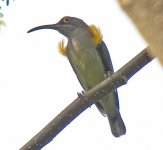Joseph Beal Steere collected dilutior on July 18, 1874. Here is a picture of the type:
http://www.lsa.umich.edu/ummz/areas/bird/type.asp?UMMZ=24780 .
At that time I think Palawan politically was divided into three districts, Calamianes, Paragua and Balabac.. In an 1888 article for Science Steere describes Palawan (biologically) as Paragua and Balabac and perhaps the Calamaines. In his 1890 list of Philippines birds Steere gives Paragua as the location for Arachnothera dilutior. R. Bowdler Sharpe’s article were he described this bird says Steere stayed on the east side of Palawan for a month in July 1874. He also went to the island of Balabac. Here is the description:
“Arachnothera dilutior, Sharpe, resembles A. longirostris, but is distinguishable by its brown lores and by the ashy whitish colour of the entire under-surface, only the flanks being slightly washed with sulphur-yellow; pectoral tufts orange-yellow. Hab. Palawan.”
Sharpe says full descriptions of the new species will be shortly prepared.
See Tran. Linn. Soc. London Ser. 2, 1, p. 341, November 1877 for a fuller description.
Shelley, Monogr. Nect. p. 363, pi. 116.
This species is closely allied to A. longirostris, " from which it
differs in having the breast white, only slightly shaded with pale
olive-yellow on the sides of the body, and in the crown being brown
with no olive shade ; throat faintly shaded with ashy brown : pec-
toral tufts bright chrome-yellow. Culmen 1*5 inch, wing 2'7, tail 1*9,
tarsus 0-75."
Everett in the Ibis (1895) says: “I find that three specimens shot and noted from dissection as females by myself at Puerto Princesa also have pectoral tufts, but smaller and paler in hue than in male birds. …The eye wattle in this bird is quite inconspicuous in dried skins, but in the living bird, when alarmed or excited, it becomes distended and forms a prominent circlet of brilliant lemon yellow. “
Arachnothera dilutior Sharpe.
Pale spider-hunters were not common, but I saw them occasionally at Brooke's Point, sometimes in company with other birds about the fiery dap-daps, sometimes alone in the deeper forest. To me they always appeared grave and solemn, with owlish demeanor, this aspect being due, no doubt, partly to their quiet habits and partly to their long bills and "spectacled" eyes. Most of my records are from Brooke's Point as are all of my specimens. One bird was seen at Bonabona.
(SOME NOTES ON THE BIRDS OF SOUTHERN PALAWAN AND
ADJACENT ISLANDS By John T. Zimmer, {Port Moresby, Papua) Philippine Journal of Science.
Die Vogel von Palawan by Blasius in Ornis says “Die ersten genauen Nachrichten uber die Vogel von Palawan verdanken wir Prof. Dr. Steere, welcher im Sommer 1874 etwa einen Monat sammelnd in Puerto-Princesa zubrachte und dabei 32, in der folgenden Liste mit einem Punkte (.) bezeichnete Arten auffand welche einege Jahr spater ...”
So Mr. Morris’s bird is a male? And it looks like dilutior as described?






